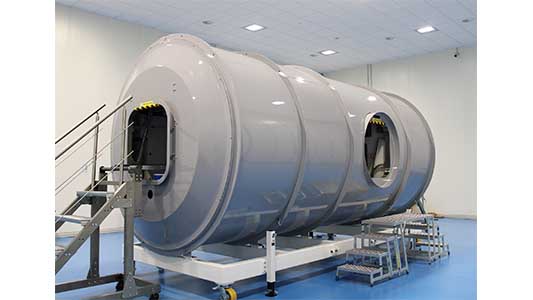At the start of this year, the European Space Agency’s Lunar I-Hab program made relevant progress at Thales Alenia Space’s Turin facility with the completion of the Acceptance Review of the mockup supplied by Liquifer Space Systems, thanks to the fine efforts of all concerned.
This milestone marks a step toward establishing a human presence inside the future European outpost in lunar orbit. The mockup is a full-scale replica of the actual flight module, incorporating a structure representing the habitable volume complemented by a cabin outfitted with volumetric models of actual flight equipment.
Thales Alenia Space, as Lunar I-Hab prime contractor, is responsible for overall program management, system engineering, definition of the functional architecture, configuration, layout and implementation of ergonomic aspects of human factors, thermal and mechanical systems, production of the primary structure, and the hatches of the docking ports. The company is also responsible for assembly, integration and testing (AIT) in line with ESA’s mission objectives and NASA’s Gateway requirements. The Lunar I-Hab mockup is thus a crucial resource, enabling the team to conduct extensive test scenarios that will play a pivotal role in guiding design activities and ensuring the system’s efficacy.
The mockup will integrate two cabin-outfitting configurations for the Human-In-the-Loop (HITL) campaign, employing increasingly sophisticated low- and medium-fidelity models.
The ready-to-use mockup will facilitate the HITL test campaign, scheduled alongside the project’s Design and Development phase. To guarantee seamless test execution, the low-fidelity model has been equipped with volumetric representations of cabin items, movable pallets, hatches and several devices to assist users during testing, the first of a series of outfits mirroring the current Lunar I-Hab design and planned for use before System CDR. Subsequent verification will progress to medium-fidelity outfitting, incorporating more detailed representations and functional crew interfaces. The final verification phase occurs at the high-fidelity level within the Lunar I-Hab module itself.
Notably, it will include special mechanisms designed to relieve the load of heavy equipment, mimicking the absence of gravity experienced by astronauts during orbital operations. Furthermore, it features springboards to aid correct motions inside the cabin.
The interactive human tasks involved in these tests serve to uncover potential design and integration bottlenecks, helping Thales Alenia Space’s team not only to tease out opportunities for refinement, but also to evaluate design synergies with human operations and ensure a successful path to verification.
HITL tests are based on a human-centric approach with test subjects representing actual users, including crew members from NASA and ESA. These participants simulate on-orbit tasks with flight-representative hardware, thereby offering a robust demonstration of the functional concept and design in terms of efficiency, safety, effectiveness, and acceptability against system requirements.











